Recently we told you that JC Penney was doing away with phony price comparisons in its stores. Other sellers, however, still need to clean up their act.
A little over a year ago, Mouse Print* spotlighted a number of grocery items at Amazon.com that they claimed were 90% off, when they were not. The company used grossly exaggerated “regular” prices to make it appear that the goods were 90% off.
After we called them on the carpet, influential blog that Mouse Print* is, the company cleaned up its act, right? Well, not quite. A quick look through their listings turned up hundreds of questionable discounts.

Here, they are claiming that 24 boxes of Kraft Macaroni and Cheese normally sell for $791.76 — or $32.99 a box.
*MOUSE PRINT:
The actual regular price at a local supermarket was $1.59 a box, or $38.16 for 24, not nearly $800 as Amazon claimed.
Here are some more examples of wildly exaggerated regular prices used to provide an illusory discount of over 90%:

*MOUSE PRINT: Supermarket price is $2.50 a box; with four boxes costing $10, not $239.
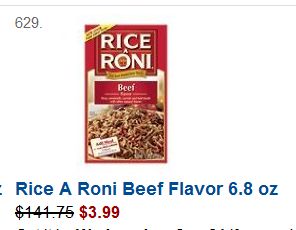
*MOUSE PRINT: Supermarket price is $1.34 a box, not over $140.
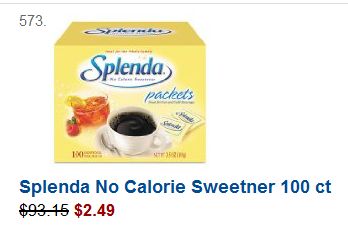
*MOUSE PRINT: Supermarket price is $4.69 a box, not over $90.
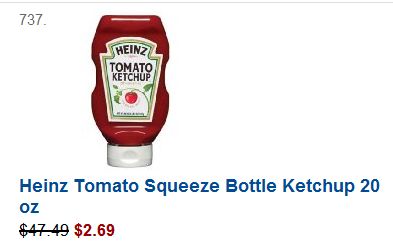
*MOUSE PRINT: Supermarket price is $1.89 a bottle, not over $47.

*MOUSE PRINT: Supermarket price is $1.79 a can, not almost $45.
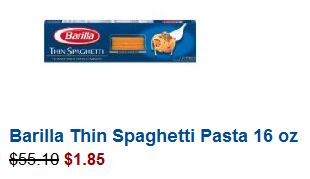
*MOUSE PRINT: Supermarket price is $1.59 a box, not $55.
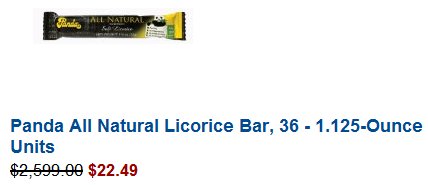
*MOUSE PRINT: And in one of the craziest savings claims ever, how could a single small package of licorice ever cost over $72, thus forming a basis for a $2599 regular price for three dozen?
In many of these cases, a third party seller has established the regular and sale prices, apparently with little oversight by Amazon. So, a word to the wise is to ignore Amazon’s savings claims, and do your own comparison of actual selling prices at a variety of stores.
You can see more wild price comparisons scattered here.

These prices are so wildly exaggerated that I doubt anyone would believe the “savings”.
Surely the licorice bar is a mistake. That’s ridiculous!
This last place I saw such wildly inflated prices was in an old Price Is Right game, Hit Me: a blackjack game where all the displayed prices (except the Ace) were multiples of the actual price.
Anyway, with all the rules Amazon has for merchants on its site, it’s amazing that they don’t call BS on inflated prices like that. But like Tundey suggested, maybe it’s so out of line that it’s not even deception anymore.
Disclaimer: This is not a defense of Amazon.com or their policies.
Due to the volume of products and number of third-party merchants using their services, I would imagine that Amazon leaves such pricing to the seller and only investigates such gross pricing overstatements when a complaint is filed.
Wow! Better jump on that deal right now before it goes back up to $800. I doubt anybody on this blog makes purchasing decisions based on the “savings %” as told them by the vendor. We are so savvy that we only buy things when we are comfortable with the final price-per-unit of measure, right?
…and where is our prone to over regulation government when this BS takes place?
And then there is the “sale” on 20 twinkies for 88 cents…..(PLUS $16.95 shipping!) I don’t remember twinkies being so heavy?!
That must be some really good licorice. Maybe hand-made, by monks, on a remote mountaintop.
Can’t some of these just be typos? For example, should the licorice should have been listed as $25.99? The rest of the information (“your savings”) etc. is then machine generated.
Harris Teeter, a grocery store located in NC, SC, VA, DE, MD, and TN, put Coca-Cola on sale, buy two get one free. The original price was $5.99, during the sale the price was $6.99. Therefore, the deal was not as good as originally thought.
Harris Teeter raised the prices and then marked them back down to the original price to make you think you are getting a good deal.
Some coupons say in fine print that they are only good at other grocery stores like Giant, Piggly-Wiggly, Publix, Stop & Shop, Best, Trader Joes, Fiesta, and Wild by Nature, other than your store. BI-LO, Food Lion, Safeway, Hannaford, and Lowes Foods’ also make coupons especially for their store, in the small print. So, when you go to a store with one of those coupons in hand, they will not accept them.
Sometimes you can get really frustrated.
Jared G.
Why would anyone buy groceries from Amazon, even at these “heavily discounted” prices? Would it do any good to complain?
Anyone who has been to a grocery store would have to laugh out loud at these prices.
This is the most ridiculous article ever, if the author would have taken any time to do any research it would have been obvious that all of these items are from third party sellers. And it’s The third party sellers that set the original price and not amazon. I understand some of the negative press that amazon has been getting, but fabricating stories is a little over the top.
Edgar replies: If you read the post, you would know that we *did* say that third party sellers are the ones doing this most times, but that Amazon needs to better monitor their practices.
From Amazon’s pricing page:
“Where an item is offered for sale by one of our merchants, the List Price may be provided by the merchant.”
http://www.amazon.com/gp/help/customer/display.html/ref=hp_468502_list?nodeId=468502#list
If products sold by amazon are priced wrong like this I’m guessing it’s a mistake or they borrowed the List Price from a merchant that listed it incorrectly.
What you are seeing with these prices are not typos or corrupt business practices. What you are seeing are the results of algorithyms and algorythmic “bots” that end up clashing and or competing with each other and driving up the price inadvertantly on products. Eventually a human will “intevene” and correct the issue.
The same thing is happening in the financial industry. There are so many automated bots and scrips running amok and no one is sure how they will interact with each other in any given system.
As for the macaroni, I would bet that list should have been 24 boxes at $32.99 and Amazon is selling at $30.86 for 24. If you look through the other listings the degrees of error are similar. Amazon is using a digital file of prices supplied by vendors or a 3rd party to provide cost comparisons. The error lies in either a unit of measure or a decimal position discrepancy between the sending and receiving parties’ understanding of what the digital data mean. The person talking about algorithms is not far off although it’s probably a much simpler situation. One of the 2 sides has to change his view. Rather than emailing customer service which will never get to the proper area in IT, try contacting Jeff Bezos. You all are clever enough I am sure there’s a way.
And don’t forget the Amazon seller “Uberi” with discounts of as much as 90%!
REF:http://www.uberi.com/amazon-discounts-table/